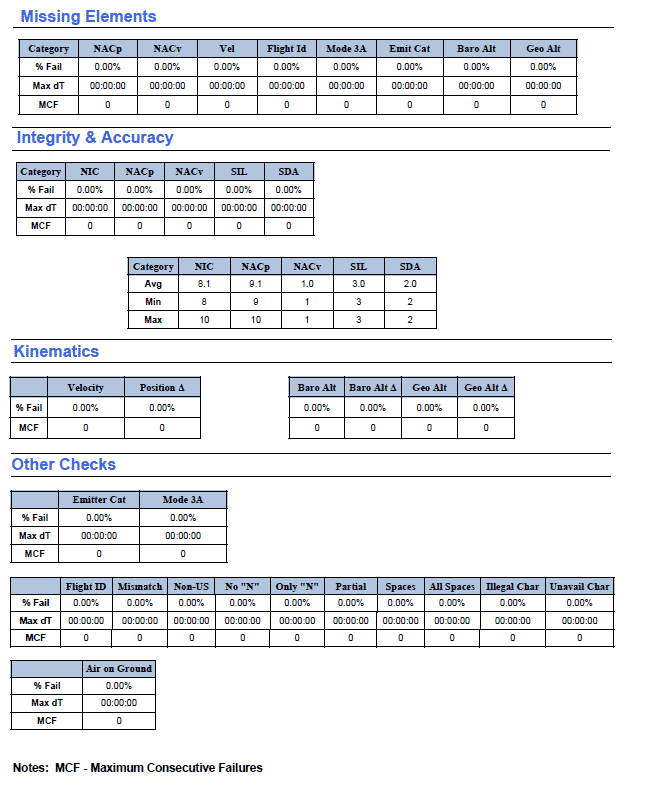It’s all about the setup:
In aviation, everything is about the setup. The preflight, the pilot’s health, the pilot’s familiarity with the aircraft, and the details of the flight determine 99% of the outcome. ADS-B evaluation flights are no different. Poor behavior and a lack of understanding lead to failed reports, more than a little frustration and burning holes in the sky. It can become very frustrating trying to achieve a successful rebate flight if you do not understand both the FAA rules and the equipment in operation.
Elements of a passing PAPR:
Here are the basic requirements for a successful PAPR flight and/or FAA Rebate Flight. Each of these items is covered in detail below.
- Fly in excellent coverage
- Give the aircraft sufficient run-up (minimum 5 minutes after avionics and skyBeacon power on)
- Avoid prolonged or aggressive maneuvers/attitudes
- 30+ minutes in rule airspace is required for rebate flights
- If the equipment is newly installed make a shorter flight of 15-20 minutes in coverage to validate the installation and configuration
Coverage:
One of the biggest contributors to failure is whether or not the aircraft is flown in good ADS-B coverage. Ever make a cellular phone call from poor coverage? The message is tough to understand if it’s breaking up. The ADS-B network is no different. Here’s a quote from the FAA automated email system:
Be advised that flight operations occurring at the fringe of ADS-B ground station coverage (refer to the FAA ADS-B Coverage Map) can cause intermittent signal losses with aircraft avionics. This condition may generate various false failure indications (red flag for Percent Failure – PF and/or Maximum Consecutive Failure – MCF flag) within a Public ADS-B Performance Report (PAPR). Such failures will vary depending on the duration of the flight in this condition. If you receive a PAPR with suspected false failure indications, please email 9-AWA-AFS-300-ADSB-AvionicsCheck@faa.gov and request that your avionics performance be manually reviewed prior to taking maintenance action. Please attach the PAPR file and include (PAPR Review Request) in the subject line of the reply email to help expedite a response.
Did you see this part? This condition may generate various false failure indications…
The FAA coverage map can be found here: FAA ADS-B Coverage Map
Run-up:
The aircraft run-up and equipment power-on time directly contribute to PAPR performance. Powering on ADS-B and other avionics immediately after engine start/engine checks will ensure optimal performance. The two devices most impacted by startup time are the skyBeacon GPS and the aircraft’s pre-existing altitude encoder. We recommend the avionics in the aircraft are given 4-5 minutes of warm-up time prior to departure.
skyBeacon GPS:
Certified aviation GPS units require more time to acquire a high-integrity fix than the consumer GPS units. NIC failures from 0.5% to 5% have been traced to very short startup times. We recommend the skyBeacon be powered up immediately after engine start and allowed 5 minutes prior to takeoff.

This aircraft did not have sufficient run-up and the GPS was reporting a low integrity value.
Altitude Encoder:
We’ve tested several popular altitude encoders and recorded their startup times. Many are temperature corrected and may not provide valid altitude to the transponder for up to 5 minutes depending on the model and ambient temperature. Taking off without valid altitude data to the Mode C transponder does not meet the requirements of 91.227. In many cases, the pilot has no visual indication the encoder has reached operating temperature. Waiting a few minutes is a good best practice.
Avoid prolonged manuevers/unsuual attitudes:
GPS, ADS-B, and transponders are all line-of-sight radios. They perform best when the antennas are unobstructed. Prolonged banks can hide GPS satellites from view or point the transponder antenna way from ground radar stations. Avoid sustained banks, steep climbs or descents. Shadowing antennas with the airframe for long durations may cause random failures. We recommend against performing numerous 360s and touch and goes during performance evaluation flights.
30+ minutes in rule airspace for rebate flights:
A successful rebate flight requires 30+ minutes in rule airspace. We’ve seen several frustrated customers who flew a total of 30+ minutes but they were only in rule airspace for 10-15 minutes.
The FAA Rebate Team accepts the following as Rule airspace:
- 10,000’+ feet Class E
- Within the Mode C Veil
- Class C Airspace
- Class B Airspace
Contrary to popular belief there is no requirement to perform touch and goes or notify ATC of your plans to perform an ADS-B performance evaluation. You are still required to comply with regulations for entry and exit from controlled airspace.
Baby Steps:
The skyBeacon is easy to install and configure but sometimes things aren’t quite right with the install. We recommend a short test flight to validate the equipment. A 15-20 minute flight in coverage is recommended. A short flight can still provide important details about the installation and the aircraft equipment. Fly 2000′ AGL in coverage for 15-20 minutes. 30 minutes after landing request a PAPR at the FAA website.
Visit: https://adsbperformance.faa.gov/paprrequest.aspx
Fill out the form with the date of flight, aircraft callsign, and equipment. Complete the ADS-B equipment selections as shown below.

After submittal, a report will be sent to the email address entered in the form. If the report shows all zeroes for the MCF and no red boxes your ADS-B system is meeting the requirements of 91.227. A sample of page 3 of the report is shown below.


